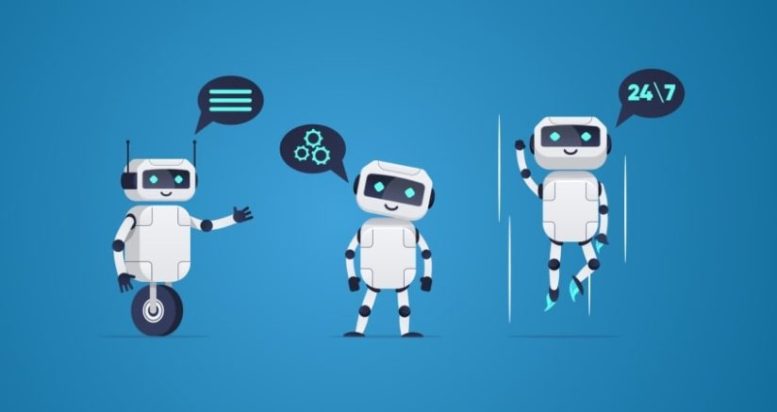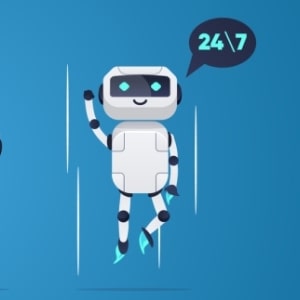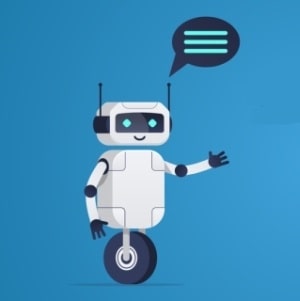Bring on the Contact Centre bots says Omningage! – Out with the IVR, in with the Bots!
The human factor
Most problems start with people.
Cloud contact centres replace the fixed costs of an on-premises solution with flexible costs that rise and fall with call volumes.
What about the people?
Agent salaries make up more than 60% of a contact centre’s running costs. Employing part timers to work during peak hours is a partial solution, but most part time shift patterns result in at least some overstaffing.

Out with the IVR, in with the Bots!
Natural Language Processing (NLP) and Artificial Intelligence (AI) can help customers navigate IVR flows and fulfil simple tasks with minimal human intervention.
 Alex Black, Global CTO of Enghouse, observed that people are increasingly making mobile devices their primary means of communication.
Alex Black, Global CTO of Enghouse, observed that people are increasingly making mobile devices their primary means of communication.
Traditional IVR queues are not easy to navigate on a mobile. Your keypad is right next to your ear as you listen to the instructions. Touchscreens are not easy to use in cold weather, when you are wearing gloves.
If a touchscreen is part of a communal device, such as an ATM, users may be reluctant to touch it to avoid spreading infection.
A bot with NLP based programming, such as Amazon Lex, can replace the IVR. You can program Lex with various “intents”. These are collections of phrases to indicate which queue a customer wants. The system will ask the customer “How can I help you?”, and then, on hearing her response, route her to the correct queue.
While the bot has been programmed with certain phrases, the NLP programming can identify variations of this language with a similar meaning, and still route the customer through to the correct queue.
This will save the customer’s time and reduce the effort they need to use your service.
Virtual Agents – What are they good for?
 A virtual agent is an automated system that can perform simple tasks for humans. It is often used to handle basic or routine requests.
A virtual agent is an automated system that can perform simple tasks for humans. It is often used to handle basic or routine requests.
 Dr. Nicola Millard, BT’s principal innovation partner, stated in a Call Centre Helper article, that bots work best for tasks that are “narrow and deep”. They are very good at completing tasks where there are strict rules and lots of available data. Ideal tasks for bots steer customers through a well-defined process, such as airport check in, making reservations, submitting structured information such as meter readings, or requesting delivery updates.
Dr. Nicola Millard, BT’s principal innovation partner, stated in a Call Centre Helper article, that bots work best for tasks that are “narrow and deep”. They are very good at completing tasks where there are strict rules and lots of available data. Ideal tasks for bots steer customers through a well-defined process, such as airport check in, making reservations, submitting structured information such as meter readings, or requesting delivery updates.
Ben Williams, the CTO of Fujitsu, described how his organization helped a UK government department adopt virtual agent technology. The result? 58.4% of callers resolved their requests through a self-service application, including virtual agents. Of that 58.4%, 89% fulfilled their requests without any intervention from a human agent, while approx. 11% of these cases required escalation to a human agent.
Are people obsolete?
 The role of human agents is changing, but people are far from obsolete.
The role of human agents is changing, but people are far from obsolete.
Nicola Millard commented that bots do not work well with emotion or sarcasm, nor do they work well with handling complaints or complexity.
When customers complain, they may not be able to express the problem clearly. They may need guidance with careful questioning to identify the problem. Customers may not know exactly what the problem is, or they may have more than one issue. Customers may well be frustrated or angry and may not be able to express themselves clearly as a result.
Increasingly, fully automated text or voice-based bots will be the first line of response. Human agents will handle cases where the automated system cannot help the customer, or where the customer wants to speak to a human agent. In either scenario, the customer may well be upset and the agent will need to employ high levels of emotional intelligence as well as technical skills to solve the customer’s issue.
Most interactions will be handled by the bots, but the interactions humans handle will be more complex, more emotional and take longer.
Where does Omningage fit in here?
 Omningage provides fully featured contact centre interfaces to run on top of the Amazon Connect platform. This includes an agent desktop, supervisor desktop and a reporting platform.
Omningage provides fully featured contact centre interfaces to run on top of the Amazon Connect platform. This includes an agent desktop, supervisor desktop and a reporting platform.
Amazon Connect can be integrated with Amazon Lex and other AWS chatbot technology.
Virtual agent interactions are treated just like human interactions for reporting and management purposes. Supervisors can just as easily investigate low NPS scores given to a bot as they can for a human. They can use these insights to improve the bots’ programming so to handle situations better or escalate them to their human colleagues.
To find out more about Omningage Connect, Amazon Connect and the potential of cloud contact centres working with bots, please get in touch.
![]()

OMNINGAGE is a cloud based Contact Centre Platform powered by Amazon Connect and AWS.
OMNINGAGE Connect is a next generation cloud based user desktop built for Amazon Connect which offers effortless user experience, promotes agent engagement and boosts staff productivity.



